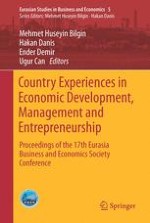2017 | OriginalPaper | Chapter
Two-Factor Model of Stratification of the Population of the Republic of Kazakhstan “Income”—“Quality of Life Index”
Authors : Tatyana Kudasheva, Svetlana Kunitsa, Bulat Mukhamediyev
Published in: Country Experiences in Economic Development, Management and Entrepreneurship
Publisher: Springer International Publishing
Activate our intelligent search to find suitable subject content or patents.
Select sections of text to find matching patents with Artificial Intelligence. powered by
Select sections of text to find additional relevant content using AI-assisted search. powered by
